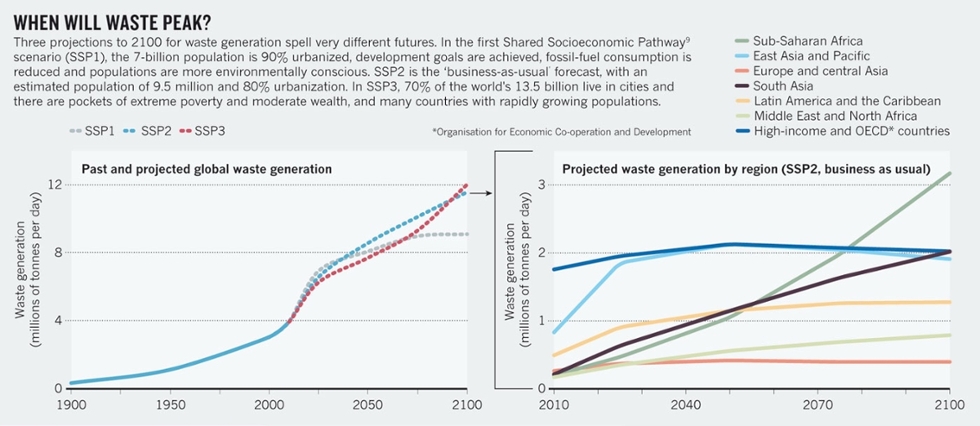Peak Waste and Poverty – A Powerful Paradox
Posted by Daniel Hoornweg on January 23, 2014
Urbanization is the most powerful force shaping the planet today. This can be good news as urbanization is the best bet we have to meet our global poverty reduction targets. Cities generate our wealth, our culture, and our innovation. This is also bad news since cities generate the lion’s share of the world’s GHG emissions, and cities are responsible for most of the planet’s current decline in biodiversity. Cities also generate solid waste; lots of it and the amount is growing fast.
‘Peak waste’ – that point in time when all the waste from all the cities finally plateaus around the world, and then slowly starts to decline, is not on track to happen this century. Estimates are that it will peak at three-times today’s current waste generation rate. Peak waste is an excellent proxy for humanity’s cumulative global environmental impact; therefore we are on track to triple today’s overall global environmental impact. Our ‘assault on the planet’ will start to subside on the other side of peak waste. Therefore we must move peak waste forward and reduce its intensity when it finally does arrive.
Ironically as organizations like the World Bank promote poverty reduction, they promote faster growth of cities, especially the larger ones, and much faster rates of solid waste growth. A recent commentary in Nature argued that waste production must peak this century. Three scenarios – ‘sustainability’, ‘business as usual’, and ‘fragmentation’ – were evaluated. The sustainability scenario takes advantage of the urbanization wave; getting more people richer and out of poverty more quickly (and growing cities faster). In the sustainability scenario populations stabilize the most quickly and peak waste can be brought forward to 2075, about 35 years sooner than the current ‘business as usual’ path.
At the heart of the shared socioeconomic pathways (SSPs) used in the study is an understanding that poverty reduction and environmental sustainability are heavily interwoven. As evident from recent IPCC work, the SSPs have become a useful approach for assessing the potential impacts of climate change on natural and human systems - but there is more to them than this. The "sustainability" scenario (SSP1) is bullish in its support for low-income countries and reductions in inequalities. The SSP1 storyline includes lower material growth and rapid development of clean energy technologies. However, it is the emphasis on poverty reduction and high levels of education leading to lower population growth that principally helps to lessen the environmental burden on the planet. This is highlighted well through the lower waste volumes in the sustainability scenario despite higher global affluence.

The back-end of poverty reduction for now is more solid waste over the couple decades. The scenarios show that waste volumes under SSP1 exceed those of the other pathways until about 2030, because of increasing affluence and faster growing cities (see Figure). But by following the sustainability scenario, enormous benefits are possible; poverty reduction and quality of life is maximized, GHG emissions are curbed the fastest, and in the long-term total solid waste volumes are actually lowered more quickly than in any other scenario.
Cities, especially those in low- and middle-income, fast-growing countries, need help with solid waste management. Denser (especially in Africa) and better managed cities consuming fewer resources, with greater equity, and more care and understanding of urban metabolism, can bring peak waste forward and down. Organizations like the World Bank, promoting poverty reduction, also need to help with better solid waste management as waste volumes grow. The environmental, economic and social benefits would be enormous.
Photo source: World Bank / John Cleave
http://blogs.worldbank.org/sustainablecities/peak-waste-and-poverty-powerful-paradox
Filed under: Sustainability 101